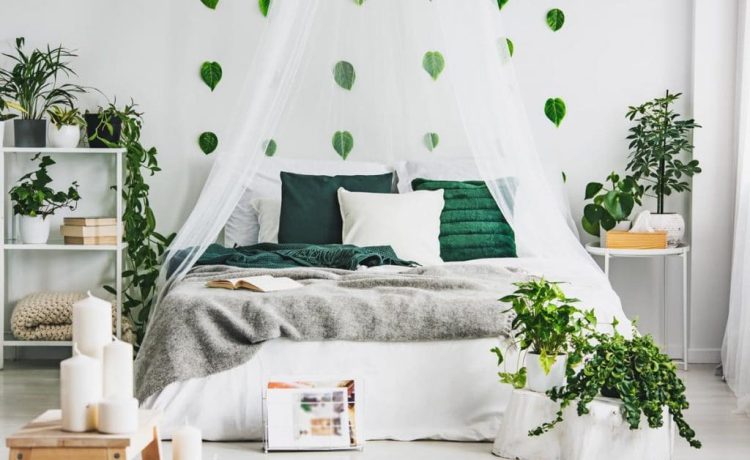Introducing plants into your bedroom can bring numerous benefits, enhancing both the visual appeal of your space and your overall well-being. Plants have the remarkable ability to create a calming atmosphere, uplift your mood, and improve air quality by increasing oxygen levels. However, before diving into plant shopping, it’s crucial to understand the specific care requirements of different plants to ensure a successful and harmonious addition to your room.
Additionally, knowing which plants are commonly recommended for bedrooms based on their low maintenance, lighting preferences, fragrance, and circadian rhythm habits can guide your selection process effectively. By considering these factors, you can make informed decisions that align with your room’s conditions and lifestyle, allowing you to enjoy the benefits of indoor greenery effortlessly.
Snake Plant
Snake plants, a popular type of succulent, are highly recommended for beginners due to their ease of growth. They are incredibly versatile and can thrive in various lighting conditions, ranging from low, indirect light to direct sunlight in the afternoon. According to Paris Lalicata, a plant expert at The Sill, snake plants have a forgiving watering schedule. It is best to allow the soil to completely dry out before watering, which may occur every one to two weeks during the spring and summer, and every two to three weeks in the fall and winter.
An additional advantage of snake plants is their unique ability to convert carbon dioxide into oxygen at night. Unlike most houseplants that perform this process during the day, snake plants continue to purify the air by releasing oxygen while you sleep, making them an excellent choice for a bedside companion.
Calathea
Calathea plants, with their captivating and vibrant foliage, are an excellent choice for enhancing the ambiance of your bedroom. According to Lalicata, these plants are particularly well-suited for keeping near your bed as they exhibit a fascinating behavior known as nyctinasty movement. This means that their leaves move up at night and lower during the daytime, following a circadian rhythm and optimizing light absorption.
Calatheas thrive in medium to bright indirect light, but they can also tolerate low indirect light. As moisture-loving plants, it’s recommended to water them when about half of the soil has dried out. Depending on environmental conditions, this may be once a week during the spring and summer, or every 10-14 days in the fall and winter.
Philodendron
Philodendrons are renowned for their stunning heart-shaped leaves and fast-growing trailing vines, which can transform any bedroom into a lush jungle. To encourage their growth, it’s ideal to position them near a window where they can receive medium-bright indirect light.
According to Lalicata, philodendrons prefer to have their soil dry out between waterings, typically requiring watering every seven to 10 days depending on the environmental conditions of your home. A visual cue that they need watering is when the leaves start to droop and curl inward. This serves as a clear indication that they are ready for a drink.
Money Tree
The money tree, believed to bring good luck and fortune, is an excellent choice for enhancing bedroom Feng Shui. With its resilient nature, ease of growth, and distinctive braided trunk, it adds a touch of charm to any space. Lalicata suggests providing the money tree with sufficient sunlight for optimal growth. It thrives best in medium-bright indirect light with occasional dappled direct sun. When it comes to watering, it is important to check the moisture level of the soil and only water when it has almost or completely dried out. In brighter light conditions, this may be required every seven to 10 days, while in shadier conditions, watering every 10-14 days should suffice.
Ficus Tineke
With its vibrant pink, green, and yellow leaves, this low-maintenance plant can bring a burst of color and visual interest to your bedroom. According to Lalicata, as long as your bedroom receives abundant sunlight, this plant will flourish and can grow to an impressive height of over 5 feet, making it a striking statement plant. Similar to money trees, ficus plants require bright light to thrive and should only be watered when the soil has nearly or completely dried out, as advised by Lalicata.
English Ivy
This plant is an ideal choice for hanging baskets and will enhance the beauty of your bedroom. According to Lindsey Hall, a botanist and expert contributor, this plant is a fast grower and doesn’t require much to thrive. Simply plant it in well-draining soil, place it in an area with bright indirect light, and water it when the top 2 inches of the soil have dried out. With these minimal care requirements, it will flourish and bring joy to your space.
Jasmine
If you experience anxiety and have trouble falling asleep, consider adding jasmine to your bedroom. The sweet scent of jasmine has a calming effect that can help reduce stress and promote relaxation. Additionally, the plant’s beauty is visually pleasing.
According to Lindsey Hall, an expert contributor, jasmine plants require regular watering as they love moisture. However, it’s important to avoid overwatering. For optimal growth, place your jasmine plant near a south-facing window. If this is not possible, windowsills of west- or east-facing windows can also provide suitable light conditions for jasmine. By following these care guidelines, you can enjoy the soothing aroma and visual appeal of jasmine in your bedroom.
Gardenia
For those with gardening skills, incorporating a flowering plant with scented blossoms like gardenia can enhance your bedroom. Lindsey Hall suggests that gardenia produces captivating white flowers, but it requires extra care and attention, making it less suitable for beginners. If you’re up for the challenge, meeting the specific care requirements is essential.
Gardenia thrives when planted in a free-draining, nutrient-rich, and acidic soil. It should be placed in an area with bright, indirect light and maintained at a humidity level of at least 60 percent. To support its growth, fertilize the plant twice at the beginning of the growing season and water it on a weekly basis, allowing the topsoil to dry out between waterings. By meeting these care requirements, you can enjoy the beauty and fragrant blooms of gardenia in your bedroom.






